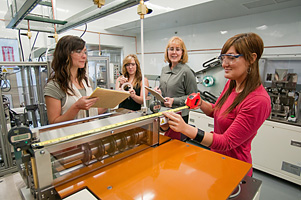Design, Housing and Merchandising faculty and student team assists Argonne National Lab
Friday, August 27, 2010
Paulette Hebert, a professor in the design, housing and merchandising department of
the College of Human Environmental Sciences at Oklahoma State University, and three
interior design students had a hand in the design and construction of a $95 million
energy research facility at the Department of Energy’s Argonne National Laboratory
near Chicago this summer.
As members of a Faculty and Student Team (FaST) led by Hebert, Stillwater senior Autry
Sneed, Tulsa junior Jessa Feagins and December 2009 graduate Brooke Brandon from Sand
Springs made up the only FaST team ever to be invited to the Facility Management Services
Division of the Argonne National Laboratory. Typically, Argonne invites individual
student interns and researchers with visiting appointments.
Hebert said she selected students for her team who excelled in courses she had taught
in previous semesters. Each student had to work through a daunting application process
which included writing a paper and receiving three letters of recommendation from
DHM faculty members.
“All of the selected students have special technical skills and expertise,” Hebert
said. “They each have a "special spark" and an interest in the more technical side
of design. They were also selected based on their facility management and design
skills, potential contributions to innovative design projects, professional interests,
previous accomplishments, team player mentality, and maturity.”
The FaST Program is a cooperative effort between the Department of Energy Office of
Science and the National Science Foundation. The goal of the program is to provide
hands-on research experiences in DOE national laboratories during the summers.
This summer’s DHM internship program provided faculty and students an opportunity
to help with the conceptual design of the new Energy Sciences Building being constructed
at the Argonne and to gather data regarding existing laboratory equipment and conditions
that would inform the planned relocation to a new facility.
“Our objective this summer was to provide facility management and design support for
new laboratories and offices where Argonne National Laboratory investigators can pursue
research and development work related to the broad field of energy,” Hebert said.
“We had a very unique, total immersion experience and we learned a lot in the very
special environment.”
Groundbreaking for the building is planned for early 2011, and a completion date is
set in late 2014. The OSU FaST team’s work supported the Energy Science Building
project and the Office of Project Management Strategic Planning group at the Argonne.
While the group was busy all summer with numerous tasks, a few of the members’ main
responsibilities included reviewing and developing floor plans and drawings, helping
to plan the efficient use of office and laboratory spaces, creating a model of the
building using 3D sketching software and gathering data regarding the existing conditions
in laboratories and scientists’ future needs.
The goal of the new energy facility is to group existing energy-related Argonne scientists
into closer proximity to each other. The design includes space for the five science
theme areas of discovery synthesis, biomimetics and solar energy, catalysis, fuel
cells and electrical energy storage.
The world-class facility will “provide an environment that will accelerate the pace
of discovery by bringing together interdisciplinary teams of researchers in a space
that can be adjusted to accommodate an evolving energy-related science agenda,” according
to an Argonne spokesperson.
Also, following DHM’s recent work in other sustainable design ventures, the group
assisted in the development and selection of energy efficient solutions required to
meet Leadership in Energy and Environmental Design (LEED) Gold requirements set by
the U.S. Green Building Council. The system provides standards for environmentally
sustainable construction.
“We are humbled and so very excited to have been selected by the Department of Energy
's Argonne National Laboratory and to have received supplemental funding from the
National Science Foundation for stipends and travel,” Hebert said. “Additionally,
Argonne also covered the housing for us for ten weeks, for which we are also very
grateful.”

